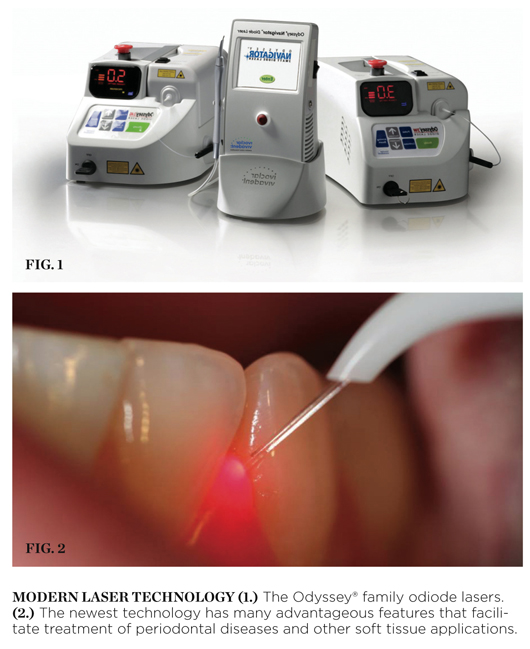Periodontal Applications of the Diode Laser
Odyssey® Navigator™ Diode Laser represents the newest technology.
Sebastiano Andreana, DDS, MS
Ivoclar Vivadent, Inc, introduced soft tissue diode lasers several years ago. The Odyssey® family of diode lasers (Figure 1) was substantially enhanced with the introduction of the Odyssey® Navigator™ Diode Laser, which represents the newest technology with many advantageous features that facilitate treatment of periodontal diseases, as well as other soft tissue applications (Figure 2). Traditionally, periodontal treatment has either involved surgical or non-surgical procedures to suppress or halt the progression of infections, regenerate tissues, and/or help the host to combat inflammations. Now, by using the Odyssey Navigator Diode Laser as an adjunct to conventional treatment, periodontal laser therapy can realize benefits such as antimicrobial efficacy, improved wound healing, greater patient acceptance, anti-inflammatory effects, and reduced postoperative pain. All this comes together in one package with the remarkable ease of use of the Soft Tissue Diode Laser Odyssey Navigator.
According to one study that focused on the use of diode lasers as an adjunct to conventional scaling and root planing, bacterial reduction was enhanced, bleeding on probing was improved, and periodontal indices were remarkably better when the diode laser was used.1
In terms of wound healing, researchers found that a diode laser used in conjunction with scaling and root planing (SRP) showed no adverse effects.2 More importantly, the study demonstrated that use of the diode laser in conjunction with SRP improved gingival health up to 3 months following the application. Additionally, patients experienced increased comfort, less pain, and reduction of tooth sensitivity after the laser was used.
Practical Technique
The Navigator™ Diode Laser can be used in continuous or pulsed mode, with the average power ranging from 0.8 to 1 W. Most patients do not require anesthesia when the laser is used at this wattage. However, if increased power is required, topical or local anesthetic is recommended as needed; wattage should not exceed 1.2 W.
The fiber tip should be inserted into the pocket only so deep that it equals the pocket depth, less 1 mm. The fiber tip then can be initiated by touching the tip to articulating paper and “test firing.” Insert the fiber in a vertical direction toward the bottom of the pocket, with the laser tip oriented slightly toward the soft tissue facing the pocket, to begin sulcular debridement. Inside a pocket, the fiber should be moved mostly in a vertical fashion at a slow to moderate speed, with the fiber tip kept in contact with the epithelium and/or parallel to the root surface. It is very important to keep the laser tip debris-free by cleaning it with a 2x2 sterile gauze; plume should be removed using high-volume evacuation. A fine water spray can be used during the laser treatment for rinsing.
The total time for the laser procedure depends on the extent of the diseased soft tissue and size of the site; there is truly no recommended time for the laser to be in the pocket. In general, pockets of 6 mm or less can be lased for approximately 30 seconds, and those greater than 6 mm can be treated with the laser for 45 seconds. If the patient experiences discomfort, the power setting can be lowered, and an anesthetic administered if necessary.
Conclusion
The Navigator Diode Laser brings modern technology to the dental office, enabling dentists to emphasize the high-end level of care they provide to their patients. It is battery-operated, highly flexible, and equipped with unit-dose fiber tips. It also features an ergonomic handpiece, procedure-specific programs, and a wireless foot pedal for easy operation. In addition to facilitating adjunctive periodontal therapy, the Navigator™ Diode Laser offers user-friendly features for such everyday dentistry procedures as soft tissue crown lengthening, gingivoplasty, tissue retraction, and other applications.
References
1. Moritz A, Schoop U, Goharkhay K, et al. Treatment of periodontal pockets with a diode laser. Lasers Surg Med. 1998;22:302-311.
2. Ciancio SG, Kazmierczak M, Zambon J, et al. Clinical effects of diode laser treatment on wound healing. AADR. 2006; Abs 2183.
This article was written by Sebastiano Andreana, DDS, MS, associate professor and director of implant dentistry at the University at Buffalo School of Dental Medicine.
For more information, contact:
Ivoclar Vivadent, Inc.
Phone: 800-533-6825
Web: https://www.ivoclarvivadent.com
Disclaimer
The preceding material was provided by the manufacturer. The statements and opinions contained therein are solely those of the manufacturer and not of the editors, publisher, or the Editorial Board of Inside Dentistry. The preceding is not a warranty, endorsement, or approval for the aforementioned products or services or their effectiveness, quality, or safety on the part of Inside Dentistry or AEGIS Communications. The publisher disclaims responsibility for any injury to persons or property resulting from any ideas or products referred to in the preceding material.






